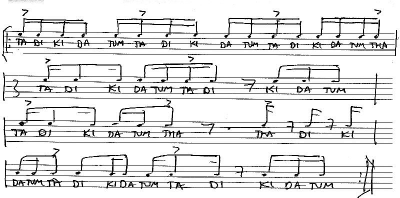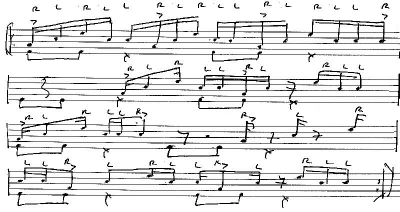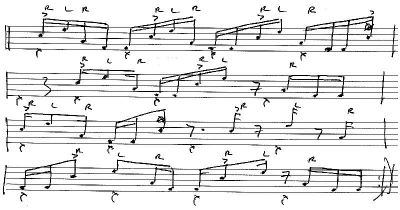| Applying Indian Rhythms 1 |
A look at the Rhythms of
South India and how to apply them musically.
Development of thematic material is something all musicians and
percussionists strive for, whether they are at the early stages of their
technical development or already well versed. No system seems to have a
deeper reservoir of methods towards this end than that of the Indian sub
continent. We will begin with a simple five beat unit called 'Kandam'
found in South Indian 'Carnatic' music. (It's worth noting that the
North and South Indian systems are quite distinct from one another, both
in their rhythmic formalities and in the drums used. In the North you
will find drums such as Tabla and Phakawaj whilst in the South it would
be the Mridangam, Kanjira, Thavil and Ghatam. This is one of the reasons
'Shakti' was such a ground breaking group back in India. Before this it
was a rarity for percussionists from the North and South to share the
same stage.)
Our five beat unit stems from a striking
pattern found on the double ended 'Mridangam' (For those of you who
might not know, each syllable in the drum language represents a stroke
or combination of strokes on the drum. It is a practical but incredibly
complex system).

EXAMPLE 1
It is then possible to mutate this phrase
into six, seven, eight and nine beat units by the addition of
strategically placed gaps. When I first began my Mridangam studies I was
informed that the placement of these gaps is a vital factor in
maintaining the idiomatic integrity and lyrical shape of the phrases.
Indeed, only rarely have I come across these phrases constructed in a
radically different fashion. Examples two, three four and five show the
respective mutations.

EXAMPLE 2

EXAMPLE 3

EXAMPLE 3 Alternative gap

EXAMPLE 4

EXAMPLE 5
For the Mridangist, the striking routine
for all these patterns would derive from the first five beat unit. This
is our basic phrase or thematic material. Notice that all the units so
far contain the same number of played notes, the syllables for which
fall in the same order each time. Similarly, we will need to find a
sticking for our basic five beat unit which will then apply to all our
derivative units. We will begin with this sticking pattern for our
phrase. RLRLL (Ex 6 ) Therefore, the derivative patterns will be as in
example seven A, B, C, and D. This will all begin to make more practical
sense when we compile larger phrases from these smaller units.

EXAMPLE 6

EXAMPLE 7a

EXAMPLE 7b

EXAMPLE 7b Alternative gap

EXAMPLE 7c

EXAMPLE 7d
For now we will keep the sticking on the
snare drum and employ the five, six and seven beat units in a rhythmic
adventure. The construct of this example involves repeating each of
these three units three times, each time followed by accented note five
sixteenth notes in length. This method of repeating identical phrases
three times is common in Indian rhythms. It is called an 'Arudie' in the
South and a ' Tihai' in the North and is mostly employed as a rhythmic
cadence to conclude a piece of rhythmic work. I find them extremely
useful as a device for creating an elusive ‘off beat time’/’over the bar
lines’ feel in a more western playing situation, as well as being great
for playing odd meters over even meters for a pre determined number of
bars. This is where the phonetics come in. If you can keep them firmly
in your mind then you can use them as a template and improvise less
rigid patterns within those time units, knowing you are going to come
out smack bang on beat one at the end of it. (Notice that after the
three groups of seven, the accented note actually becomes beat one of
the next bar. This is the whole point of the rhythmic cadence.) For now
we will recite the syllables as in example eight whilst clapping a
steady quarter note pulse.

EXAMPLE 8 Click to enlarge

Now we will apply this to the kit whilst
keeping steady time with the feet. It might be an idea to play four bars
of eighth note groove followed by the example each time. The sticking is
the same as our earlier sticking pattern. Try also to recite the
syllables aloud whilst playing. Believe me, it helps.

EXAMPLE 9 Click to enlarge

The final example involves keeping time
with the left foot whilst employing a more linear style pattern for the
phrases. If you fancy challenging the throne of 'El Negro' then why not
try it with the left foot clave as well. GOOD LUCK!!!!!

EXAMPLE 10 Click to enlarge


|
